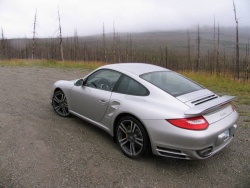 2010 Porsche 911 Turbo. Click image to enlarge |
 Follow Autos on Twitter Follow Autos on Twitter |
Article and photos by Haney Louka
Photo Gallery:
2010 Porsche 911
I’d seen this type of e-mail before. Tony Morris, Porsche’s Western Canadian press fleet manager, sent me a note asking if I could move one of his cars to Winnipeg from another city. I’ve only taken him up on this kind of offer once before, to drive a Cayenne S from Saskatoon a few years ago. It was a great drive on the Yellowhead Highway that follows a northwest-to-southeast path through the Prairies.
But this time, it was different. That’s because the car would be waiting in Calgary, not Saskatoon. And this was no Cayenne S, either. No sir: Tony was asking me to drive home from Calgary in a Porsche 911 Turbo. In my ten years as an automotive journalist, I had yet to get behind the wheel of one of these beasts, and while there are more track-oriented members of the 911 family, this one has the whole package and, to me, has represented the pinnacle of the Porsche model line ever since I was a kid.
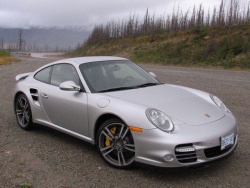 2010 Porsche 911 Turbo. Click image to enlarge |
So this one was a no-brainer, but there was only one problem. If you’ve ever driven the Trans-Canada Highway between Calgary and Winnipeg you’ll likely recall that there’s one turn at Regina and that’s about it. Cruise control might was well be auto-pilot on this route. I knew that to make this drive special, I’d have to go out of my way a bit.
There was also a time constraint, so I thought I’d benefit from some help to cover more ground in less time (as if the 500 horsepower and all-wheel drive weren’t enough). I enlisted the help of friend and co-worker Derek Mizak to be co-pilot for this weekend adventure, which he later described as the fulfilment of a childhood dream. I’m pretty sure he was talking about the car and not the company.
We decided that we’d need to go south or west from Calgary and at least get a taste of the Rockies before heading back across the Prairies. We thought about going west to Banff, north on the Icefields Parkway to Jasper, and then heading back east through Edmonton. In the end, with the help of Google Maps, we planned a route that would take us south from Cowtown across the U.S. border into Montana, heading back east through North Dakota.
We arrived in a soggy Calgary around noon, where we were met by auto journalist Amee Reehal who had been driving the car before us. At least he was being let down easy; his ride for the following week was a Nissan 370Z convertible. I had seen the forecast for the areas we’d be travelling in and knew it would be raining. Little did I know, though, that we’d only see about four hours of dry roads during the entire 2,200-km trek.
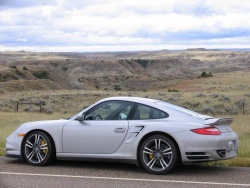 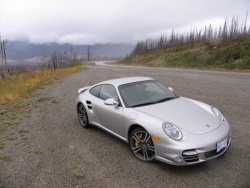 2010 Porsche 911 Turbo. Click image to enlarge |
With the airport being so close to Highway 2, also known as the Deerfoot Trail within Calgary city limits, we were on our way in no time. We opted to stay on 2 southbound rather than heading east through Lethbridge to maintain our proximity to the hills, entering the U.S. at Piegan, Montana. The following few hours saw the most scenic area of our drive; it’s too bad the low-lying clouds, constant rain, and three-degree weather weren’t the optimal conditions in which to enjoy the landscape. But none of that mattered, since we were, after all, behind the wheel of arguably one of the most livable exotics on the planet.
With a starting price of $167,900, the Turbo costs about a Boxster S more than a base 911 Carrera. While the 500 horses (making it the third most-powerful of the—count ‘em!—twenty 911 variants) and all-wheel drive make the headlines, there are plenty of other features that are optional or not available on other 911 models. Items like six-piston front and four-piston rear brakes, Porsche Active Suspension Management, 19-inch alloys, power sunroof, bi-xenon headlights, touch-screen navigation, and Bose surround sound are all part of the Turbo package. To make it even more special, our ride was adorned with more than $25,000 in extras, chief among them the $12,050 ceramic composite brakes and $6,200 PDK dual-clutch transmission. Other optional goodies included cocoa leather, aluminum interior trim, adaptive sport seats, a rear differential lock, and a PDK Sports steering wheel with aluminum shift paddles.
Despite being only 44 mm wider and 10 mm lower than a Carrera coupe, the Turbo manages a far more menacing road presence. The huge air intakes that reside just ahead of the rear wheel wells are reserved for turbocharged models only. Our tester wore the beautiful standard-issue 19-inch wheels which have elegantly thin double spokes, allowing a fine view of the ceramic-composite rotors and yellow brake calipers.
The weather did clear later that afternoon, and we used the opportunity to sample the massive waves of torque afforded by the twin-turbo flat-six. U.S. 89 follows a sinuous path through St. Mary and produced exactly the kind of driving experience we were looking for when we opted to take the scenic route home. It’s a relatively narrow two-lane road, but the speed limit is 70 mph (112 km/h) and the asphalt is smoother than anything we have here in Manitoba.
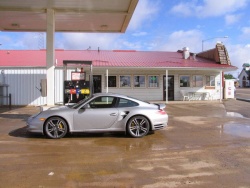 2010 Porsche 911 Turbo. Click image to enlarge |
While it’s frustrating to have to deal with speed limits when piloting a car like this, the 911 Turbo is capable of doing some very entertaining things within the confines of legal driving. Which is what we did the whole time. Honest.
For example, one can sample the launch control feature to experience what the perfect combination of all-wheel drive, tons of power, and a very smart transmission can offer. Simply come to a complete stop and push the “Sport Plus” button. Left foot goes on brake, right foot on throttle (all the way to the floor), and an indicator on the right spoke of the sport steering wheel notifies that launch control has been activated. The computer holds the engine revs at 5,000 rpm and waits for the driver to release the brake. What follows is akin to revving a car with a conventional manual to redline and side-stepping the clutch. But it all happens with engineered excellence as the computer controls the clutch engagement and manages wheelspin (of all four wheels on dry pavement!) to have you on your way in no time at all.
You’ll want to remove your foot from the throttle after about three and a half seconds, though, because any longer than that and you’re speeding.
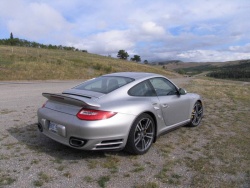 2010 Porsche 911 Turbo. Click image to enlarge |
The other ace up the Turbo’s sleeve is the pavement-wrinkling braking ability afforded by the car’s optional ceramic-composite brakes. Trying this out requires a clear view behind to make sure nobody’s even close. The process for sampling the brakes is somewhat simpler than activating launch control, but I recommend that you inform your passengers regarding what’s about to happen so they can tighten their grip on whatever’s in their hands. Hit the brakes from highway speed and you can come to a rest somewhere between two and three seconds later.
We stopped for dinner in Great Falls, Montana with the intention of continuing on another three hours southeast to Billings, but Mother Nature had other plans. As we were scarfing down a greasy-spoon-type meal anxious to continue on our adventure, a thunderstorm rolled in and unleashed a torrent of rain and even a bit of hail. We started on our way to Billings but after ten minutes turned back because, well, we couldn’t see the road in front of us. And according to the Porsche’s GPS navigation system, there was really very little along that 218-mile route that would serve as a good rest stop.
We awoke on Monday morning to partly-cloudy skies and were on the road shortly after 6 a.m. Our unplanned overnight stop in Great Falls meant that we had to drive nearly 1,400 km to get back to Winnipeg. No problem, we thought, since the rain was over and there was nothing but badlands and prairie between us and home. We thought wrong. Apparently a Porsche 911 Turbo moves across the plains a lot faster than a weather disturbance, and soon we found ourselves driving through some very angry thunderstorms.
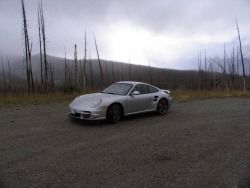 2010 Porsche 911 Turbo. Click image to enlarge |
For the next twelve hours we saw nothing but heavy rain pelting the car’s windshield. It was so heavy at times that our cruising speed dipped below 100 km/h just so we could see where we were going.
Porsche promotes its cars as machines that are meant to be enjoyed year-round. I’ve been impressed by all-wheel drive Carreras that the company has sent to us in the dead of winter, and now that I’ve experienced the Turbo in heavy rains I have a new level of respect for the marque.
Not once did the car try to hydroplane on the rain-soaked road surface, nor was there a sore muscle in my body after a long day behind the wheel. Supremely adjustable and supportive sport seats, telepathic steering response, and a suspension that magically soaks up the bumps while staying firm in the twisties can all be thanked for that. The 911 Turbo is truly a supercar for all seasons.
The fulfilment of a childhood dream? I couldn’t agree more.











